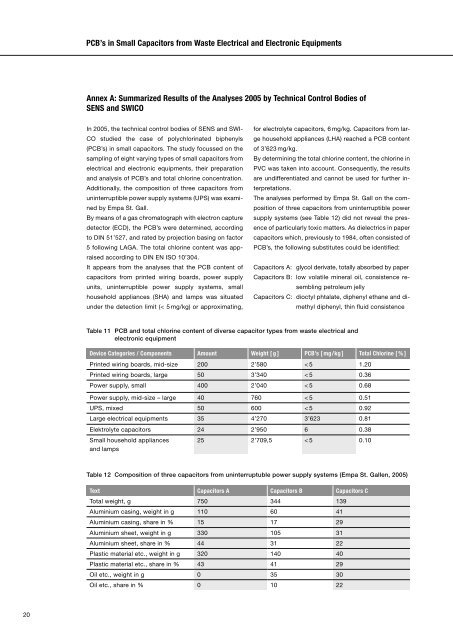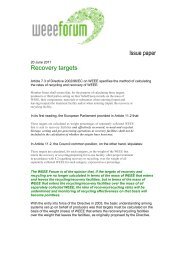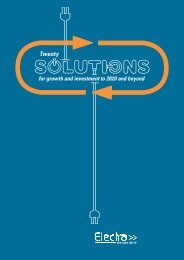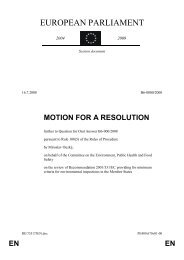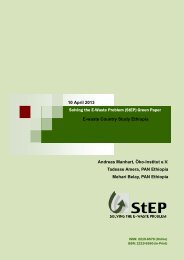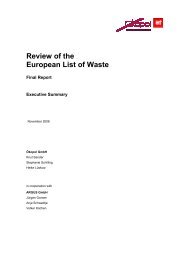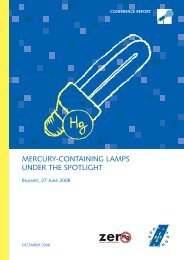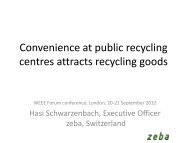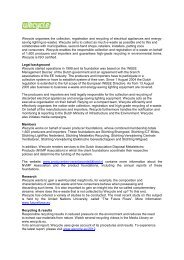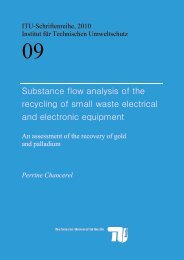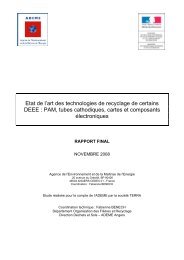by SENS and SWICO - Ecotic
by SENS and SWICO - Ecotic
by SENS and SWICO - Ecotic
You also want an ePaper? Increase the reach of your titles
YUMPU automatically turns print PDFs into web optimized ePapers that Google loves.
PCB’s in Small Capacitors from Waste Electrical <strong>and</strong> Electronic EquipmentsAnnex A: Summarized Results of the Analyses 2005 <strong>by</strong> Technical Control Bodies of<strong>SENS</strong> <strong>and</strong> <strong>SWICO</strong>In 2005, the technical control bodies of <strong>SENS</strong> <strong>and</strong> SWI-CO studied the case of polychlorinated biphenyls(PCB’s) in small capacitors. The study focussed on thesampling of eight varying types of small capacitors fromelectrical <strong>and</strong> electronic equipments, their preparation<strong>and</strong> analysis of PCB’s <strong>and</strong> total chlorine concentration.Additionally, the composition of three capacitors fromuninterruptible power supply systems (UPS) was examined<strong>by</strong> Empa St. Gall.By means of a gas chromatograph with electron capturedetector (ECD), the PCB’s were determined, accordingto DIN 51’527, <strong>and</strong> rated <strong>by</strong> projection basing on factor5 following LAGA. The total chlorine content was appraisedaccording to DIN EN ISO 10’304.It appears from the analyses that the PCB content ofcapacitors from printed wiring boards, power supplyunits, uninterruptible power supply systems, smallhousehold appliances (SHA) <strong>and</strong> lamps was situatedunder the detection limit (< 5 mg/kg) or approximating,for electrolyte capacitors, 6 mg/kg. Capacitors from largehousehold appliances (LHA) reached a PCB contentof 3’623 mg/kg.By determining the total chlorine content, the chlorine inPVC was taken into account. Consequently, the resultsare undifferentiated <strong>and</strong> cannot be used for further interpretations.The analyses performed <strong>by</strong> Empa St. Gall on the compositionof three capacitors from uninterruptible powersupply systems (see Table 12) did not reveal the presenceof particularly toxic matters. As dielectrics in papercapacitors which, previously to 1984, often consisted ofPCB’s, the following substitutes could be identifi ed:Capacitors A: glycol derivate, totally absorbed <strong>by</strong> paperCapacitors B: l ow volatile mineral oil, consistence resemblingpetroleum jellyCapacitors C: d ioctyl phtalate, diphenyl ethane <strong>and</strong> dimethyldiphenyl, thin fl uid consistenceTable 11 PCB <strong>and</strong> total chlorine content of diverse capacitor types from waste electrical <strong>and</strong>electronic equipmentDevice Categories / Components Amount Weight [ g ] PCB’s [ mg/kg ] Total Chlorine [ % ]Printed wiring boards, mid-size 200 2’580 < 5 1.20Printed wiring boards, large 50 3’340 < 5 0.36Power supply, small 400 2’040 < 5 0.68Power supply, mid-size – large 40 760 < 5 0.51UPS, mixed 50 600 < 5 0.92Large electrical equipments 35 4’270 3’623 0.81Elektrolyte capacitors 24 2’950 6 0.38Small household appliances<strong>and</strong> lamps25 2’709,5 < 5 0.10Table 12 Composition of three capacitors from uninterruptuble power supply systems (Empa St. Gallen, 2005)Text Capacitors A Capacitors B Capacitors CTotal weight, g 750 344 139Aluminium casing, weight in g 110 60 41Aluminium casing, share in % 15 17 29Aluminium sheet, weight in g 330 105 31Aluminium sheet, share in % 44 31 22Plastic material etc., weight in g 320 140 40Plastic material etc., share in % 43 41 29Oil etc., weight in g 0 35 30Oil etc., share in % 0 10 2220


